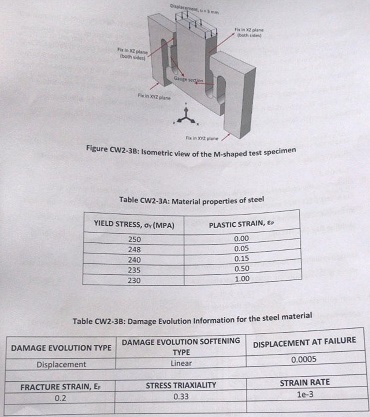Reference no: EM132478706
Problem 1: The meshed model of a bath is shown in Figure CW2-2. The bath is made of steel of Young's Modulus, E = 210 GPa. The mesh is based on 2D quadrilateral element. We are interested in developing the element formulation for our bespoke four-node quadrilateral element whose isoparametric natural coordinates are given in Figure CW2-2.
For the quadrilateral element:
i. Show derivations of the relevant element shape functions, Ni where i = 1, 2, 3, 4, needed to describe the element formulation for the quadrilateral element.
ii. The plot of the four shape functions
iii. Derive the resulting strain-displacement matrix, B of this element type.
iv. Using the B-matrix above and material properties, derive the applicable stiffness matrix, K that will be used within the finite element solver for this new element type.

Figure CW2-2: A bath discretized with quadrilateral element. Insert shows the isoparametric natural coordinates of the bespoke quadrilateral element.

Problem 2:
An m-shaped specimen, shown in figure CW2-3A, is used to determine the dynamic tensile behaviour of a steel specimen within a split Hopkinson Pressure Bar apparatus. The dimensions of the test specimen are given in Figure CVV2-3A and the specimen is made from steel with properties given In Table CW2.3A.
The upper end of the specimen is imposed with a compressive displacement. U = 3 mm while both bases are fixed securely in all X, Y and Z-axes. The side faces are fixed in XZ-plane allowing for movement only in the Y-axis. The steel plate is to be modelled using an elastoplastic material model with isotropic softening given in Table CW2-3A and damage evolution law with properties given in Table CW2-38.
i. Create the virtual domain of the M-shaped tensile test specimen in an appropriate software of your choice. Create a nodal set for the gauge sections of the test specimen.
ii. Undertake the compressive test simulation for the specimen using hexahedral elements with ELEMENT DELETION switched to ON. Show contour plots from your simulation for the Von Mises stress (MISES), equivalent plastic strain (PEEQ), displacement, (U MAGNITUDE) and actively yielding flag (AC YIELD).
Using simulation outputs, determine the plot of volume averaged y-stress (S22) versus y-axis strain stress (E22) for only the gauge section elements.
From your simulations, calculate the error between numerical and analytical yield stresses determined from your study? Discuss three sources of the errors from your study.
